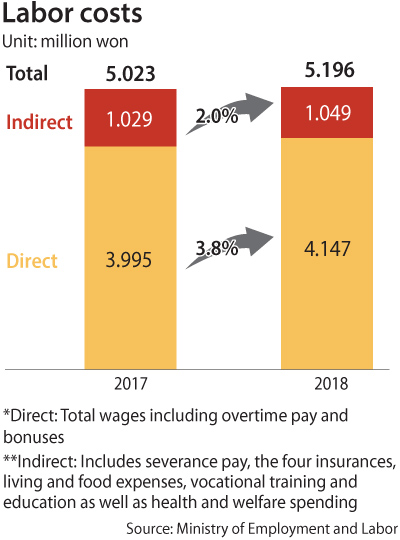Labor costs rose fastest in years on minimum wage jump

According to a study by the Ministry of Employment and Labor released on Wednesday, last year, companies with more than 10 employees spent an average of 5.193 million won ($4,318.50) per month for each new hire.
That is up 3.4 percent, or 172,000 won, from a year earlier, which itself was up 1.8 percent from 2016. The 2018 rate of growth was the fastest since 2012, when wages for single-person hires grew 3.7 percent.
The expenses not only include regular wages, overtime pay and bonuses but also indirect pay, including the four basic insurances - health, employment, industrial accident compensation and pension - and other health and welfare spending.
The study was conducted between May and June with roughly 3,500 companies.
Wages including bonuses grew 3.8 percent compared to the previous year to 4.147 million won from 3.996 million won in 2017. Indirect labor expenses were up 2 percent to 1.049 million won.
The direct labor expenses accounted for 79.8 percent of all expenses, which is an increase from 79.5 percent in 2017. Indirect labor expenses were 20.2 percent of all expenses made in hiring new regular employees, a slight drop from 20.5 percent the previous year.
Among the direct expenses, regular wages and overtime pay grew 4.5 percent year-on-year. Bonuses increased 0.7 percent.
The burden grew sharply on non-wages related spending. Last year the burden of the four mandatory insurances increased 5.6 percent.
Welfare expenses were up 3.8 percent.
The increase in direct wages and mandatory insurances was related to the increase in the government’s minimum wage. The Moon Jae-in administration raised the minimum wage 16.4 percent in 2018, which was the highest in nearly two decades.
However, severance packages dropped 1.4 percent, while spending related to recruitment dropped 1.9 percent.
According to industry experts, a drop in recruitment-related spending indicates that last year companies were reluctant about hiring.
The burden was different for different companies.
The burden rose sharply for companies more sensitive to the increase in the minimum wage. Labor expenses grew between 6 and 8 percent in the wholesale and retail, construction, logistics, lodging, facility maintenance and restaurant categories, while wages grew between 0.3 and 3.4 percent for industries that are less affected by the higher minimum wage, including manufacturing, mining, utilities and finance categories.
Monthly labor expenses were the highest for utilities companies, at 8.82 million won last year, followed by the financial industry including insurance, at 8.77 million won. Manufacturing came in at 5.92 million won. The facility maintenance category, which includes jobs like security and cleaning, had the lowest labor expenses, at 2.55 million won a month on average. The lodging and restaurant category was the second lowest, at 3.35 million won.
The average labor expenses at large companies with more than 300 employees grew 1.5 percent to 6.32 million won.
For smaller companies with fewer than 300 employees, the average expenses were 4.28 million won, a 4.9 percent increase.
“The labor expenses of small companies are now 67.7 percent of those of their larger counterpart, a 2.1 percentage point rise compared to the previous year,” said an official at the Labor Ministry.
“This shows that the wage and welfare gap between small and big companies is narrowing.”
BY LEE HO-JEONG [lee.hojeong@joongang.co.kr]










with the Korea JoongAng Daily
To write comments, please log in to one of the accounts.
Standards Board Policy (0/250자)